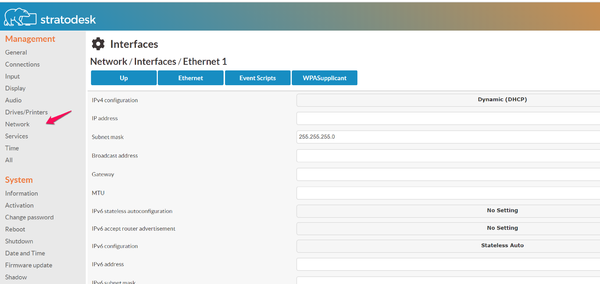A network interface, no matter if wired or wireless, is represented as a configuration object in NoTouch.
When the system boots, stored configuration objects are matched with actual physical interfaces present in the system and then the actual configuration files and scripts are automatically generated.
IP configuration
Any network interface, no matter if wired (Ethernet) or wireless (WiFi/Wireless LAN), needs to get an IP configuration, meaning an IP address, subnet mask and in most cases also a default gateway (router) address. Most people rely on dynamic IP configuration using the DHCP protocol, whereas others prefer to manually set IP addresses on each machine - the latter is referred to as static IP configuration.
The IP configuration settings are configured on a per-interface basis. Thus, keep in mind it's not the host that has an IP address, it's the interface, that gets an IP address (contrary to public opinion or lazy speech).
In the local configuration application, click on Network, click on Interfaces, and then select the interface you want to configure - then you'll see the IP configuration parameters.

The following parameters define the IP configuration:
- IPv4 configuration. Defines if the IP configuration should be configured dynamically (DHCP) or statically (see parameters below) or disabled at all.
- IP address. If the IP configuration is set to static, this parameter contains the desired IP address.
- Subnet mask. If the IP configuration is set to static, this parameter contains the subnet mask to be used.
- Broadcast address. If the IP configuration is set to static, this parameter contains the broadcast address to be used.
- Gateway. If the IP configuration is set to static, this parameter contains the desired default gateway (router) address.
If you use a static configuration, you may have to set other settings as well, such as host name and DNS addresses. Please read on here for more information: Network configuration
Event scripts
There are several customization hooks that allow to execute custom code at certain network-related events. To understand the following parameters, consider that interfaces will be brought up (=configured) and shut down (=deconfigured) by the system. You can add code before it is brought up, and after it is brought up, as well as before the interface shut down is started and after it has ended. Furthermore consider that these are processes and involve several commands each, so you can define it you want your code to be executed at the beginning of the "before going up" sequence or at the end, for instance.
- Pre-Up first command. Shell command executed at the begin of the command sequence that's executed before bringing an interface up.
- Pre-Up last command. Shell command executed at the end of the command sequence that's executed before bringing an interface up.
- Post-Up first command. Shell command executed at the begin of the command sequence that's executed after bringing an interface up.
- Post-Up last command. Shell command executed at the end of the command sequence that's executed after bringing an interface up
- Pre-Down first command. Shell command executed at the begin of the command sequence that's executed before bringing an interface down.
- Pre-Down last command. Shell command executed at the end of the command sequence that's executed before bringing an interface down.
- Post-Down first command. Shell command executed at the begin of the command sequence that's executed after bringing an interface down.
- Post-Down last command. Shell command executed at the end of the command sequence that's executed after bringing an interface down.
Please note: Some complex Network authentication or Wireless LAN setups may not allow customization hooks to run. If in doubt, check the /etc/network/interfaces file manually.
Ethernet / Wireless LAN
Depending on the type of interface, there will be a subgroup named Ethernet or one named Wireless LAN, containing specific settings. Please consult the individual articles for more information:
WPASupplicant
WPASupplicant is a very low-level way to configure Network authentication on a given interface. Normally you don't need this as almost everything can be done in the Ethernet or Wireless LAN configuration settings. Please consult the WPASupplicant article for more information, if interested.
